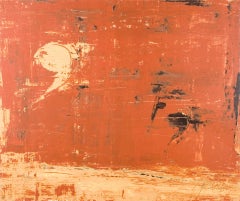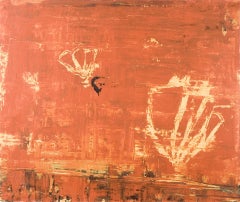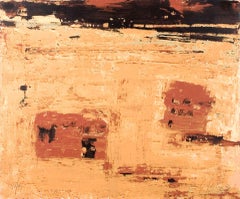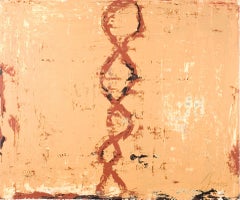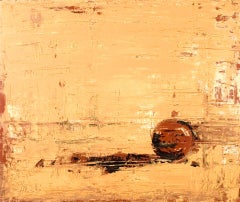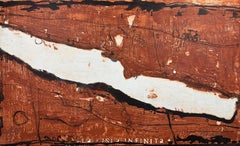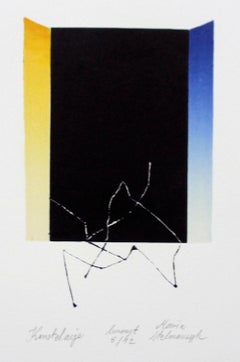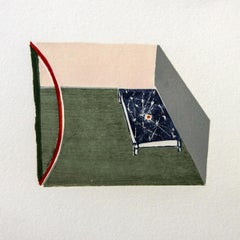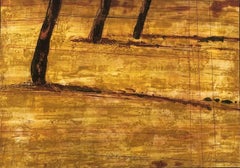Carlos García de la Nuez Abstract Prints
to
6
2
3
1
Overall Width
to
Overall Height
to
12
12
637
205
165
164
1
11
1
12
10
5
5
5
5
12
Artist: Carlos García de la Nuez
"Pauses" 2006 Original Abstract Hand Signed silkscreen Print Cuban Artist
By Carlos García de la Nuez
Located in Miami, FL
Carlos Garcia De La Nuez (Cuba, 1959)
'Pausas', 2006
silkscreen on paper
19.7 x 23.7 in. (50 x 60 cm.)
Edition of 99
Unframed
ID: GAR1649-006-104
____________________________________________
"Carlos García de la Nuez. Born in Havana, Cuba, 1959. Lives and works in Mexico City, Mexico.
He is a member of the renowned 1980s generation of Cuban artists, whose works differentiated from other contemporaries, noticeably in their intentional distancing from political criticism as a form of expression. This generation was interested in establishing and legitimizing new values of art for art’s sake, gathering inspiration from art movements happening outside of Cuba. Born in Havana, Cuba in 1959, the artist’s paintings explore abstraction and semiotics through the use of color, texture and scale. García de la Nuez participated in the historic 1982 exhibition titled 4x4 with colleagues Gustavo Acosta...
Category
Early 2000s Contemporary Carlos García de la Nuez Abstract Prints
Materials
Ink, Screen
"Night Seashell" 2006 Original Abstract Hand Signed silkscreen Print Cuban Art
By Carlos García de la Nuez
Located in Miami, FL
"Carlos Garcia De La Nuez (Cuba, 1959)
'Caracoles nocturnos', 2006
silkscreen on paper
19.7 x 23.7 in. (50 x 60 cm.)
Edition of 104
ID: GAR1649-007-104"
____________________________________________
"Carlos García de la Nuez. Born in Havana, Cuba, 1959. Lives and works in Mexico City, Mexico.
He is a member of the renowned 1980s generation of Cuban artists, whose works differentiated from other contemporaries, noticeably in their intentional distancing from political criticism as a form of expression. This generation was interested in establishing and legitimizing new values of art for art’s sake, gathering inspiration from art movements happening outside of Cuba. Born in Havana, Cuba in 1959, the artist’s paintings explore abstraction and semiotics through the use of color, texture and scale. García de la Nuez participated in the historic 1982 exhibition titled 4x4 with colleagues Gustavo Acosta...
Category
Early 2000s Contemporary Carlos García de la Nuez Abstract Prints
Materials
Ink, Screen
"My Two Houses" 2006 Original Abstract Hand Signed silkscreen Print Cuban Artist
By Carlos García de la Nuez
Located in Miami, FL
"Carlos Garcia De La Nuez (Cuba, 1959)
'Mis dos casas', (My Two Houses) 2006
silkscreen on paper
19.7 x 23.7 in. (50 x 60 cm.)
Edition of 99
ID: GAR1649-005-104"
____________________________________________
"Carlos García de la Nuez. Born in Havana, Cuba, 1959. Lives and works in Mexico City, Mexico.
He is a member of the renowned 1980s generation of Cuban artists, whose works differentiated from other contemporaries, noticeably in their intentional distancing from political criticism as a form of expression. This generation was interested in establishing and legitimizing new values of art for art’s sake, gathering inspiration from art movements happening outside of Cuba. Born in Havana, Cuba in 1959, the artist’s paintings explore abstraction and semiotics through the use of color, texture and scale. García de la Nuez participated in the historic 1982 exhibition titled 4x4 with colleagues Gustavo Acosta...
Category
Early 2000s Contemporary Carlos García de la Nuez Abstract Prints
Materials
Ink, Screen
"My DNA" 2006 Original Abstract Hand Signed silkscreen Print Cuban Artist
By Carlos García de la Nuez
Located in Miami, FL
"Carlos Garcia De La Nuez (Cuba, 1959)
'My DNA', 2006
silkscreen on paper
19.7 x 23.7 in. (50 x 60 cm.)
Edition of 99
ID: GAR1649-004-104"
____________________________________________
"Carlos García de la Nuez. Born in Havana, Cuba, 1959. Lives and works in Mexico City, Mexico.
He is a member of the renowned 1980s generation of Cuban artists, whose works differentiated from other contemporaries, noticeably in their intentional distancing from political criticism as a form of expression. This generation was interested in establishing and legitimizing new values of art for art’s sake, gathering inspiration from art movements happening outside of Cuba. Born in Havana, Cuba in 1959, the artist’s paintings explore abstraction and semiotics through the use of color, texture and scale. García de la Nuez participated in the historic 1982 exhibition titled 4x4 with colleagues Gustavo Acosta...
Category
Early 2000s Contemporary Carlos García de la Nuez Abstract Prints
Materials
Ink, Screen
"Games" 2006 Original Abstract Hand Signed silkscreen Print Cuban Artist
By Carlos García de la Nuez
Located in Miami, FL
"Carlos Garcia De La Nuez (Cuba, 1959)
'Juegos', 2006
silkscreen on paper
19.7 x 23.7 in. (50 x 60 cm.)
Edition of 99
ID: GAR1649-003-104"
____________________________________________
"Carlos García de la Nuez. Born in Havana, Cuba, 1959. Lives and works in Mexico City, Mexico.
He is a member of the renowned 1980s generation of Cuban artists, whose works differentiated from other contemporaries, noticeably in their intentional distancing from political criticism as a form of expression. This generation was interested in establishing and legitimizing new values of art for art’s sake, gathering inspiration from art movements happening outside of Cuba. Born in Havana, Cuba in 1959, the artist’s paintings explore abstraction and semiotics through the use of color, texture and scale. García de la Nuez participated in the historic 1982 exhibition titled 4x4 with colleagues Gustavo Acosta...
Category
Early 2000s Contemporary Carlos García de la Nuez Abstract Prints
Materials
Ink, Screen
"The Infinite Island" Artist Proof engraving abstract texture 42x71in (video)
By Carlos García de la Nuez
Located in Miami, FL
"Carlos Garcia de la Nuez (Cuba, 1959)
'La Isla Infinita', 2014
P/A (Artist Proof)
woodcut and collagraph on paper Velin Arches 300 g.
42.2 x 70.9 in. (107 x 180 cm.)
Edition of 20
I...
Category
2010s Contemporary Carlos García de la Nuez Abstract Prints
Materials
Woodcut
Carlos Garcia De La Nuez Cuban Artist Original Hand Signed silkscreen
By Carlos García de la Nuez
Located in Miami, FL
Carlos Garcia De La Nuez (Cuba, 1959)
'No hay color', 1991
silkscreen on paper
19.7 x 27.6 in. (50 x 70 cm.)
Edition of 50
Unframed
ID: GAR1649-000-050
____________________________________________
"Carlos García de la Nuez. Born in Havana, Cuba, 1959. Lives and works in Mexico City, Mexico.
He is a member of the renowned 1980s generation of Cuban artists, whose works differentiated from other contemporaries, noticeably in their intentional distancing from political criticism as a form of expression. This generation was interested in establishing and legitimizing new values of art for art’s sake, gathering inspiration from art movements happening outside of Cuba. Born in Havana, Cuba in 1959, the artist’s paintings explore abstraction and semiotics through the use of color, texture and scale. García de la Nuez participated in the historic 1982 exhibition titled 4x4 with colleagues Gustavo Acosta...
Category
1990s Contemporary Carlos García de la Nuez Abstract Prints
Materials
Paper, Ink, Engraving, Aquatint
"Love" 2003 Engraving in copper metal 15x19.5 in abstract
By Carlos García de la Nuez
Located in Miami, FL
Carlos Garcia de la Nuez (Cuba, 1959)
'Amor ', (Love) 2003
Engraving on paper
15 x 19.5 in. (38 x 49.5 cm.)
Edition of 20
ID: GAC-101
Category
Early 2000s Contemporary Carlos García de la Nuez Abstract Prints
Materials
Engraving
Carlos Garcia de la Nuez "El juego", 2005, Etching 28x40in
By Carlos García de la Nuez
Located in Miami, FL
Carlos Garcia de la Nuez (Cuban, 1959)
'El juego', 2005
Engraving
71 x 101 cm. (28 x 39.8 in.)
Edition of 99
Category
2010s Contemporary Carlos García de la Nuez Abstract Prints
Materials
Paper, Ink, Etching
Carlos Garcia De La Nuez Cuban Artist Original Hand Signed engraving
By Carlos García de la Nuez
Located in Miami, FL
"Carlos Garcia De La Nuez (Cuba, 1959)
'El juego', 2005
engraving on iron
27.6 x 39.4 in. (70 x 100 cm.)
Edition of 106
ID: GAR1649-001-106"
____________________________________________
"Carlos García de la Nuez. Born in Havana, Cuba, 1959. Lives and works in Mexico City, Mexico.
He is a member of the renowned 1980s generation of Cuban artists, whose works differentiated from other contemporaries, noticeably in their intentional distancing from political criticism as a form of expression. This generation was interested in establishing and legitimizing new values of art for art’s sake, gathering inspiration from art movements happening outside of Cuba. Born in Havana, Cuba in 1959, the artist’s paintings explore abstraction and semiotics through the use of color, texture and scale. García de la Nuez participated in the historic 1982 exhibition titled 4x4 with colleagues Gustavo Acosta...
Category
Early 2000s Contemporary Carlos García de la Nuez Abstract Prints
Materials
Paper, Ink, Engraving, Aquatint
Carlos García de la Nuez, ¨Amor III¨, 2004, Engraving, 12.6x29.9 in
By Carlos García de la Nuez
Located in Miami, FL
"Carlos Garcia de la Nuez (Cuba, 1959)
'Amor III', 2004
engraving on paper Guarro Biblos 250g.
12.6 x 30 in. (32 x 76 cm.)
Edition of 50
ID: GAC-110"
Category
Early 2000s Contemporary Carlos García de la Nuez Abstract Prints
Materials
Paper, Ink, Engraving, Aquatint
Carlos García de la Nuez, ¨Desde una isla¨, 2005, Engraving, 28x39.8 in
By Carlos García de la Nuez
Located in Miami, FL
Carlos Garcia de la Nuez (Cuba, 1959)
'Desde una Isla', 2005
engraving on paper Velin Arches 300 g.
28 x 39.8 in. (71 x 101 cm.)
Edition of 99
Unframed
ID: GAC-111
Hand-signed by author
___________________________________________________________
Carlos García de la Nuez. Born in Havana, Cuba, 1959. Lives and works in Mexico City, Mexico.
He is a member of the renowned 1980s generation of Cuban artists, whose works differentiated from other contemporaries, noticeably in their intentional distancing from political criticism as a form of expression. This generation was interested in establishing and legitimizing new values of art for art’s sake, gathering inspiration from art movements happening outside of Cuba. Born in Havana, Cuba in 1959, the artist’s paintings explore abstraction and semiotics through the use of color, texture and scale. García de la Nuez participated in the historic 1982 exhibition titled 4x4 with colleagues Gustavo Acosta, José Franco and Moses Finalé.
In 1979 García de la Nuez entered the San Alejandro Academy of Arts and in 1983 completed his studies at the Instituto Superior de Arte in Havana. He received his Masters of Arts in 1988 from the Massachusetts College of Art and Design in Boston, upon receiving a scholarship from the Rockefeller Foundation. He spent a decade working and living in Paris, where he exhibited across Europe and was selected to participate in a silkscreen portfolio, Kinderstem, published by Domberger-Edition in Germany that featured García de la Nuez along with Max Bill, Sol LeWitt, Keith Haring, Christo, among others. In the early 1990’s García de la Nuez relocated in Mexico City, where he currently works and lives.
The artist’s works have been exhibited in various museums around the world including Boston, New York, Miami, Buenos Aires, Sao Paulo, Rio de Janeiro, Bogota, Mexico City, San Jose, Panama City, Canada, Paris, Berlin, Stuttgart, London, Madrid, Moscow and Havana.
His work has been awarded the Painting Award 13 de Marzo...
Category
Early 2000s Contemporary Carlos García de la Nuez Abstract Prints
Materials
Paper, Ink, Engraving, Aquatint
Related Items
Constellation - XXI Century, Contemporary Linocut & Woodcut Print, Abstract
By Maria Stelmaszczyk
Located in Warsaw, PL
MARIA STELMASZCZYK (born in 1983) Studies at the Faculty of Graphic Arts and Painting
Laboratory of Woodcut Techniques and Artistic Book at the Academy of Fine Arts Władysław Strzemi...
Category
Early 2000s Contemporary Carlos García de la Nuez Abstract Prints
Materials
Paper, Linocut, Woodcut
$160 Sale Price
20% Off
H 5.52 in W 3.55 in
Room with a red arch - XXI Century, Contemporary Linocut Woodcut Print, Colorful
By Maria Stelmaszczyk
Located in Warsaw, PL
Maria Stelmaszczyk is a Polish artist born in 1983.
PROVENANCE
Exhibited at Katarzyna Napiorkowska Gallery.
The Gallery is a primary representative for this artist.
The Gallery o...
Category
Early 2000s Contemporary Carlos García de la Nuez Abstract Prints
Materials
Paper, Woodcut, Linocut
$160 Sale Price
20% Off
H 3.55 in W 4.73 in
"The Sun Shines All Over", Vintage Geometric Abstract Landscape Screen Print
By Xiu-ping Liao
Located in Soquel, CA
"The Sun Shines All Over", a bold minimalist vintage abstract landscape print by the renowned printmaker Shiou-ping Liao (Taiwanese, b.1936). A perfectly circular, high voltage rainb...
Category
1960s Abstract Geometric Carlos García de la Nuez Abstract Prints
Materials
Paper, Printer's Ink, Screen
$825
H 16.25 in W 20.25 in D 0.75 in
"Fish Dish"- Figurative Abstract Still-Life
By Morag Muir
Located in Soquel, CA
"Fish Dish" by Morag Muir (Scottish, b. 1960). Screen print on paper Signed "Morag Muir" and dated "87" lower right. Titled "Fish Dish" center and numbered "...
Category
1980s Abstract Expressionist Carlos García de la Nuez Abstract Prints
Materials
Printer's Ink, Laid Paper, Screen
$1,996 Sale Price
20% Off
H 35 in W 48 in D 2 in
"Sun Dance" Vibrant Mid Century Serigraph
By Kenneth W. Auvil
Located in Soquel, CA
Wonderful mid-century abstract serigraph by Kenneth William Auvil (American, b. 1925.) This serigraph features botanical and floral motifs in a bright color palette of yellows and or...
Category
1950s Abstract Carlos García de la Nuez Abstract Prints
Materials
Ink, Screen, Paper
Visual Aid for Band Aid SIGNED 104 British artists: David Hockney, Bridget Riley
Located in New York, NY
David Hockney, Bridget Riley, Joe Tilson, Howard Hodgkin, Peter Blake + 99 artists
Visual Aid for Band Aid - designed, and HAND SIGNED and annotated by 104 renowned artists, with official signed COA, 1985
Large olor silkscreen on velin Arches 300 gsm paper with publishers' blind stamp and COA
Signed and annotated in various inks and pencil by all 104 artists listed in the official publishers' COA affixed to the back of the frame; numbered 215/500
Publisher
Coriander Studio, United Kingdom
Frame included: Floated and framed in a wood frame under UV acrylic glazing
Measurements:
Framed:
59.5 inches (vertical) by 39 inches (horizontal) by .75 inches (depth)
Artwork:
48 inches (vertical) by 36 inches (horizontal)
Some of the 104 renowned visual artists who signed and annotated this print in pencil are:
Bridget Riley, David Hockney, Peter Blake, Allen Jones, Eduardo Paolozzi, Elisabeth Frink, R.B. Kitaj, Richard Hamilton, Howard Hodgkin, Joe Tilson, Patrick Heron, Paula Rego, Terry Frost, Patrick Caulfield, Craigie Aitchison. Gillian Ayres, Maggi Hambling, Michael Craig-Martin, Frank Bowling, Humphrey Ocean...
Category
1980s Contemporary Carlos García de la Nuez Abstract Prints
Materials
Ink, Permanent Marker, Pencil, Screen
Japanese Living Room - Modern Geometric Screen Print
By Yuichiro Kato
Located in Soquel, CA
A minimal geometric silkscreen of a traditional Japanese living room with cushions and a portable hand warmer by Yuiichiro Kato (Japanese, b- 1926). Displayed in a metal frame. Image...
Category
1970s Post-Modern Carlos García de la Nuez Abstract Prints
Materials
Printer's Ink, Laid Paper, Screen
$639 Sale Price
20% Off
H 16.5 in W 19 in D 1 in
Figurative Abstract Angel Screen Print with Poem, "Like a Breeze Passing"
By Deborah Rumer
Located in Soquel, CA
Ethereal figurative abstract print of two figures merging by Deborah Rumer (American, 20th Century). Titled "Like a breeze passing...", numbered (Ed100), signed, and dated (© Deborah...
Category
1990s Contemporary Carlos García de la Nuez Abstract Prints
Materials
Paper, Ink, Screen
$300 Sale Price
20% Off
H 12 in W 9 in D 0.03 in
Norcamphor from “40 Woodcut Spots"
By Damien Hirst
Located in Calabasas, CA
Artist: Damien Hirst
Title: Norcamphor from “40 Woodcut Spots"
Year: 2011
Medium: Woodcut on 410gsm Somerset White Paper
Edition: 43/55; signed (recto) and numbered (verso) in penci...
Category
2010s Contemporary Carlos García de la Nuez Abstract Prints
Materials
Woodcut
Crabs, The World is Changing Lt Ed 126/150 skateboard deck political protest art
By Ai Weiwei
Located in New York, NY
Ai Weiwei
Crabs, 2010-11
Limited Edition, hand numbered Silkscreen on 100% Canadian 2-Ply Maplewood Skateboard. Signed on the deck
31 × 1 × 3/10 inches
Edition 126/150
Signed on the ...
Category
2010s Contemporary Carlos García de la Nuez Abstract Prints
Materials
Wood, Ink, Mixed Media, Screen
$4,875 Sale Price
35% Off
H 31 in W 8 in D 0.3 in
Methionine, from 12 Woodcut Spots Damien Hirst Spot Print, YBA Abstract print
By Damien Hirst
Located in Bristol, GB
Woodcut in colours on Somerset White paper
Edition of 48
Signed on the front
Artwork in mint condition. Artwork not inspected outside of frame. Minor scratches throughout frame
Float...
Category
21st Century and Contemporary Contemporary Carlos García de la Nuez Abstract Prints
Materials
Woodcut
$35,215
H 24.73 in W 31.89 in
Rabbit Trial Proof 4
Located in Nashville, TN
"Rabbit Trial Proof 4" is a unique 2-color, trial-proof screen print on paper by AI artist Tom White. This piece was created using neural networks trained on images of real rabbits t...
Category
2010s Abstract Carlos García de la Nuez Abstract Prints
Materials
Paper, Ink, Screen
Previously Available Items
Carlos García de la Nuez, ¨Desde una isla¨, 2005, Engraving, 28x39.8 in
By Carlos García de la Nuez
Located in Miami, FL
"Carlos Garcia de la Nuez (Cuba, 1959)
'Desde una Isla', 2005
engraving on paper Velin Arches 300 g.
28 x 39.8 in. (71 x 101 cm.)
Edition of 99
ID: GAC-111"
Category
Early 2000s Contemporary Carlos García de la Nuez Abstract Prints
Materials
Paper, Ink, Engraving, Aquatint
Carlos García De La Nuez abstract prints for sale on 1stDibs.
Find a wide variety of authentic Carlos García de la Nuez abstract prints available for sale on 1stDibs. You can also browse by medium to find art by Carlos García de la Nuez in etching, ink, paper and more. Much of the original work by this artist or collective was created during the 21st century and contemporary and is mostly associated with the contemporary style. Not every interior allows for large Carlos García de la Nuez abstract prints, so small editions measuring 24 inches across are available. Carlos García de la Nuez abstract prints prices can differ depending upon medium, time period and other attributes. On 1stDibs, the price for these items starts at $500 and tops out at $1,200, while the average work can sell for $600.
